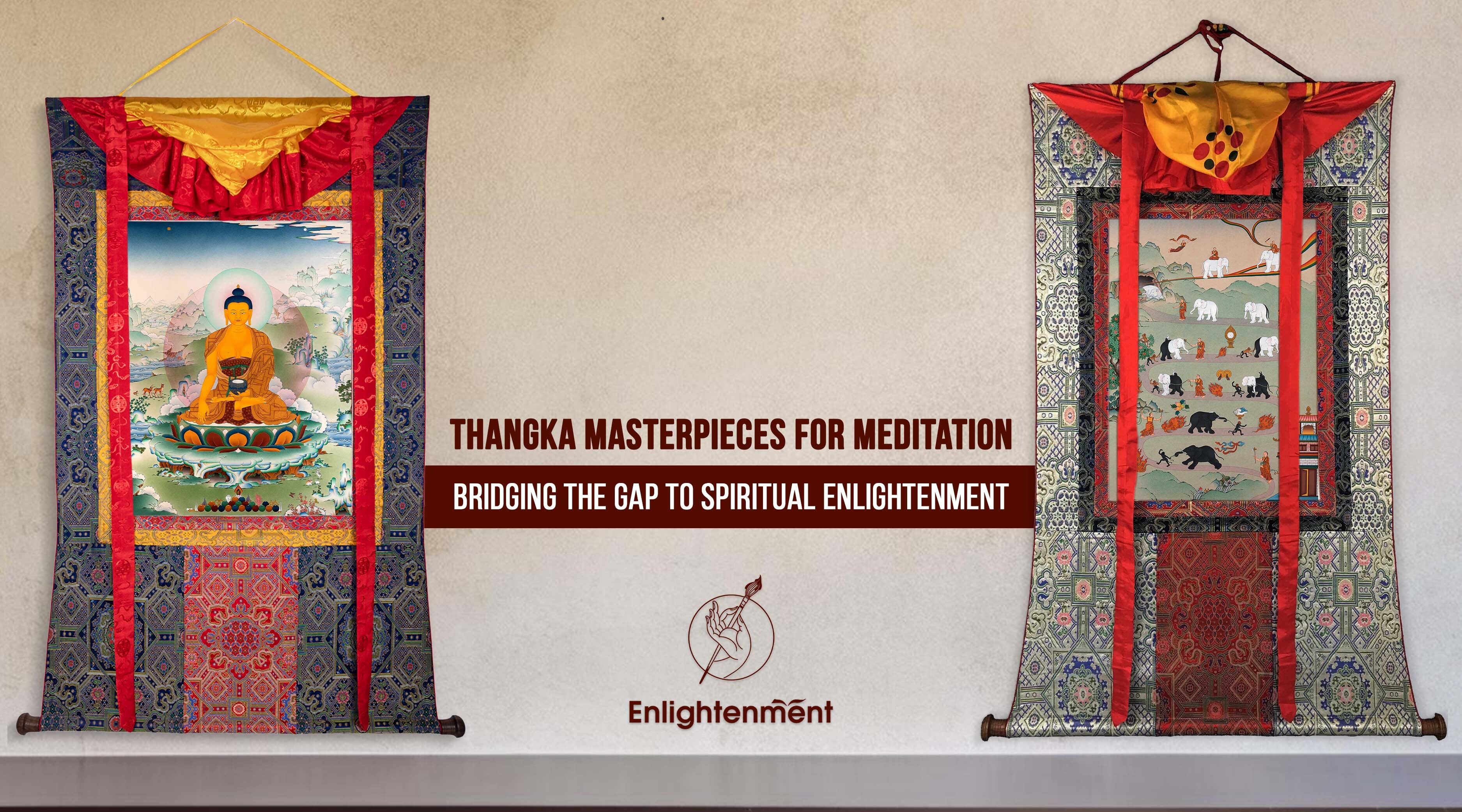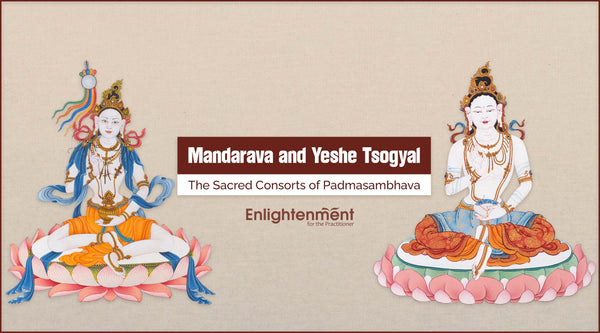Elevate Your Meditation Experience with Sacred Thangka Art
Meditation and spiritual enlightenment hold a timeless significance in diverse cultures throughout history. One of the visually stunning aids on this path is the Thangka masterpiece. These intricate Tibetan paintings, executed on cotton or silk appliqué, frequently depict Buddhist deities, scenes, or mandalas. Beyond their artistic appeal, Thangkas serve a dual purpose as captivating artworks and invaluable spiritual instruments, offering guidance to those seeking enlightenment.
Key Takeaways:
- Thangka masterpieces are intricate Tibetan paintings deeply rooted in Buddhist traditions.
- They serve as visual aids for meditation and convey profound spiritual concepts.
- Thangkas's elaborate designs and vibrant colors are rich in symbolic meanings, acting as a bridge between the physical world and the realms of the spirit.
Understanding the Essence of Thangka: Its Origin
Click here to view our Shakyamuni Buddha Thangka For Meditation
Thangka paintings are deeply rooted in the Tibetan Buddhist tradition. Over the centuries, they have served as decorative pieces and as aids for meditation. These exquisite masterpieces originate in the Himalayan regions, spanning Nepal, Tibet, and parts of India.
Thangkas primarily serve as meditation guides. Their intricate images visually represent the spiritual realm, facilitating the practitioner's concentration and absorption of Buddhist teachings. Each color, symbol, and line within a Thangka masterpiece carries profound significance, directing the meditators toward enlightenment.
The Symbolism in Thangka Paintings
In Thangka paintings, colors are not just chosen for their aesthetic appeal. Each hue holds profound significance:
| Color | Meaning |
| White | Purity, Truth |
| Blue | Tranquility, Depth Of Spirituality |
| Red | Passion, Energy |
| Yellow | Rootedness, Renunciation |
| Green | Balance, Harmony |
Common Symbols and Their Interpretations
Thangkas are filled with intricate symbols, each bearing its significance:
- Wheel of Dharma: Represents the path to enlightenment.
- Lotus Flower: Symbolizes purity and spiritual emergence.
- Endless Knot: A representation of interdependence and the interconnectedness of life.
Artistic Elements of Thangka
Thangka encompasses more than just spiritual symbolism; it's a fusion of artistic elements laden with profound meanings. The selection of colors, intricate patterns, and even the choice of materials all contribute to its essence.
| Elements | Significance |
| Colors | Different colors often represent various Buddhas or bodhisattvas. For example, green might symbolize Tara, the female Buddha of compassion. |
| Mandalas | Circular designs that represent the universe or a cosmic order. They serve as focus points for meditation. |
| Motifs | Common symbols such as lotuses (purity), conch shells (proclamation of the dharma), and the endless knot (interdependence) frequently appear in Thangka. |
Historical Roots of Meditation
Meditation, with its origins stretching back thousands of years, has deep-seated roots in various cultures and religions. Whether in Buddhist monasteries, Hindu temples, or within the contemplative traditions of Christianity, meditation has consistently served as a means for achieving spiritual enlightenment and personal growth.
| Culture/ Religion | Primary Meditation Technique |
| Buddhism | Mindfulness & Loving-kindness |
| Hinduism | Mantra & Transcendental |
| Christianity | Contemplative prayer |
| Taoism | Inner observation |
Thangka as a Bridge to Spiritual Enlightenment
- Visual Aids in Meditation

Click here to view our Samatha Meditation Thangka Print
A core function of Thangka art is to act as a meditative aid. Through their intricate designs and depictions, Thangka paintings frequently convey representations of Buddhist deities, scenes from the lives of the Buddhas, or intricate mandalas symbolizing the universe.
The objective is to assist meditators in honing their focus enhancing their ability to visualize, and internalizing these intricate depictions. Gazing upon a Thangka enables practitioners to intensify their concentration, enrich their visualizations, and advance on their spiritual path.
- Teaching and Transmission Tool
In addition to their role in meditation, Thangkas also function as educational tools employed by Buddhist masters. Frequently, they are revealed in monastic settings during special religious events or teachings, effectively illustrating the stories and concepts being imparted.
- Representation of the Divine
Beyond its role in meditation, Thangka is also a manifestation of the divine. Each brush stroke and color in a Thangka painting carries profound symbolism, representing different facets of Buddhist theology and cosmology.
For example, the portrayal of deities in wrathful forms is not intended to instill fear but to symbolize eradicating negative emotions and obstacles on the journey toward enlightenment.
Using Thangka in Meditation Practice
For those keen to integrate Thangka into their meditation:
- Position the Thangka: Hang or place the Thangka at eye level within your meditation space.
- Sit Comfortably: Assume your usual meditation posture.
- Gaze and Focus: Commence by gently gazing at the Thangka, allowing its colors, patterns, and designs to immerse your field of vision.
- Visualize: While continuing your meditation, internalize the image, envisioning it within the canvas of your mind.
- Deepen the Practice: As time progresses, utilize the Thangka to enhance concentration, visualize teachings, or simply as a grounding anchor to the present moment.
Benefits of Meditation Practice
Physical Benefits
- Stress Reduction: Meditation decreases the levels of the stress hormone cortisol.
- Enhanced Immunity: Regular practice can boost the immune system.
- Improved Sleep: Meditation can help combat insomnia and improve sleep quality.
Psychological Benefits
- Mental Clarity: Clears mental clutter, aiding in decision-making and problem-solving.
- Emotional Stability: Reduces emotional volatility, fostering calm reactions.
- Enhanced Creativity: Clears the mind, allowing innovative ideas to emerge.
Spiritual Benefits
- Self-awareness: Offers deeper insights into one's nature and purpose.
- Connection: Fosters unity with the universe or a higher power.
- Enlightenment: Consistent practice can lead to profound spiritual realizations in some traditions.
Benefits of Using Thangka in Meditation
- Enhanced Concentration: The intricate imagery of Thangka serves as an instant focal point, promoting heightened concentration by anchoring the mind.
- Deepened Understanding: Thangka's symbolic nature invites exploration and comprehension of intricate Buddhist teachings.
- Improved Visualization: As a visual aid, Thangka provides an immediate image for visualization, a vital component in specific Tibetan meditation practices.
- Connection to Tradition: Incorporating Thangka into meditation aligns the practitioner with centuries of Tibetan Buddhist tradition, enriching the overall experience.
Thangka masterpieces transcend mere art; they serve as a bridge, connecting the meditator with the expansive realm of spiritual enlightenment. By grasping the profound symbolism within these paintings and integrating them into meditation routines, individuals can journey to spiritual enlightenment with unwavering focus and clarity. If you are looking to buy thangka for meditation then here's a complete guide on 'How to Buy a Thangka'.


